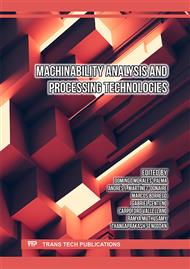[1]
R. K. Gupta, B. Pant, and P. P. Sinha, "Theory and Practice of γ + α2 Ti Aluminide: A Review," Trans. Indian Inst. Met., vol. 67, no. 2, p.143–165, Apr. 2014.
DOI: 10.1007/s12666-013-0334-y
Google Scholar
[2]
F. Appel, R. Wagner, and V. Kumar, "Intermetallics: Titanium Aluminides," in Reference Module in Materials Science and Materials Engineering, Elsevier, 2017.
DOI: 10.1016/b978-0-12-803581-8.02542-x
Google Scholar
[3]
J. C. Williams and R. R. Boyer, "Opportunities and Issues in the Application of Titanium Alloys for Aerospace Components," Metals (Basel)., vol. 10, no. 6, p.705, May 2020.
DOI: 10.3390/met10060705
Google Scholar
[4]
H. Clemens and H. Kestler, "Processing and Applications of Intermetallic γ-TiAl-Based Alloys," Adv. Eng. Mater., vol. 2, no. 9, p.551–570, Sep. 2000.
DOI: 10.1002/1527-2648(200009)2:9<551::aid-adem551>3.0.co;2-u
Google Scholar
[5]
J. . Kuang, R. . Harding, and J. Campbell, "Microstructures and properties of investment castings of γ-titanium aluminide," Mater. Sci. Eng. A, vol. 329–331, p.31–37, Jun. 2002.
DOI: 10.1016/S0921-5093(01)01539-8
Google Scholar
[6]
L. E. Murr et al., "Characterization of titanium aluminide alloy components fabricated by additive manufacturing using electron beam melting," Acta Mater., vol. 58, no. 5, p.1887–1894, Mar. 2010.
DOI: 10.1016/j.actamat.2009.11.032
Google Scholar
[7]
S. Biamino et al., "Electron beam melting of Ti–48Al–2Cr–2Nb alloy: Microstructure and mechanical properties investigation," Intermetallics, vol. 19, no. 6, p.776–781, Jun. 2011.
DOI: 10.1016/j.intermet.2010.11.017
Google Scholar
[8]
M. A. K. Chowdhury, A. S. Ullah, and R. Teti, "Optimizing 3D Printed Metallic Object's Postprocessing: A Case of Gamma-TiAl Alloys," Materials (Basel)., vol. 14, no. 5, p.1246, Mar. 2021.
DOI: 10.3390/ma14051246
Google Scholar
[9]
S. Castellanos and J. Lino Alves, "A review of milling of gamma titanium aluminides," U.Porto J. Eng., vol. 3, no. 2, p.1–9, 2017.
DOI: 10.24840/2183-6493_003.002_0001
Google Scholar
[10]
E. García-Martínez, A. Martínez-Martínez, M. C. Manjabacas, and V. Miguel, "Proposal of a combined experimental-simulation methodology for the evaluation of machining temperature in turning processes," Meas. J. Int. Meas. Confed.
DOI: 10.1016/j.measurement.2021.110632
Google Scholar
[11]
S. Castellanos, A. Cavaleiro, A. de Jesus, R. Neto, and J. L. Alves, "Machinability of titanium aluminides: A review," Proc. Inst. Mech. Eng. Part L J. Mater. Des. Appl., p.146442071880938, Nov. 2018.
DOI: 10.1177/1464420718809386
Google Scholar
[12]
E. Aust and H.-R. Niemann, "Machining of γ-TiAl," Adv. Eng. Mater., vol. 1, no. 1, p.53–57, Sep. 1999, doi: 10.1002/(SICI)1527-2648(199909)1:1<53::AID-ADEM53>3.0.CO;2-3.
DOI: 10.1002/(sici)1527-2648(199909)1:1<53::aid-adem53>3.0.co;2-3
Google Scholar
[13]
E. García-Martínez, V. Miguel, A. Martínez-Martínez, M. C. Manjabacas, and J. Coello, "Sustainable Lubrication Methods for the Machining of Titanium Alloys: An Overview," Materials (Basel)., vol. 12, no. 23, p.3852, Nov. 2019.
DOI: 10.3390/ma12233852
Google Scholar
[14]
A. Beranoagirre, D. Olvera, and L. N. López de Lacalle, "Milling of gamma titanium–aluminum alloys," Int. J. Adv. Manuf. Technol., vol. 62, no. 1–4, p.83–88, Sep. 2012.
DOI: 10.1007/s00170-011-3812-6
Google Scholar
[15]
E. García-Martínez, V. Miguel, A. Martínez, J. A. Naranjo, and J. Coello, "Tribological characterization of tribosystem Ti48Al2Cr2Nb-coated/uncoated carbide tools at different temperatures," Wear, vol. 484–485, p.203992, Nov. 2021.
DOI: 10.1016/j.wear.2021.203992
Google Scholar
[16]
P. C. Priarone, F. Klocke, M. G. Faga, D. Lung, and L. Settineri, "Tool life and surface integrity when turning titanium aluminides with PCD tools under conventional wet cutting and cryogenic cooling," Int. J. Adv. Manuf. Technol., vol. 85, no. 1–4, p.807–816, Jul. 2016.
DOI: 10.1007/s00170-015-7958-5
Google Scholar
[17]
P. C. Priarone, M. Robiglio, L. Settineri, and V. Tebaldo, "Effectiveness of Minimizing Cutting Fluid Use when Turning Difficult-to-cut Alloys," Procedia CIRP, vol. 29, p.341–346, 2015.
DOI: 10.1016/j.procir.2015.02.006
Google Scholar
[18]
F. Klocke, D. Lung, M. Arft, P. C. Priarone, and L. Settineri, "On high-speed turning of a third-generation gamma titanium aluminide," Int. J. Adv. Manuf. Technol., vol. 65, no. 1–4, p.155–163, Mar. 2013.
DOI: 10.1007/s00170-012-4157-5
Google Scholar
[19]
E. García-Martínez, V. Miguel, A. Martínez-Martínez, J. Coello, J. A. Naranjo, and M. C. Manjabacas, "Optimization of the Dry Turning Process of Ti48Al2Cr2Nb Aluminide Based on the Cutting Tool Configuration," Materials (Basel)., vol. 15, no. 4, p.1472, Feb. 2022.
DOI: 10.3390/ma15041472
Google Scholar
[20]
W. Zhao, J. Tan, Z. Xue, and S. Fu, "SEST: A new error separation technique for ultra-high precision roundness measurement," Meas. Sci. Technol., vol. 16, no. 3, p.833–841, 2005.
DOI: 10.1088/0957-0233/16/3/027
Google Scholar
[21]
A. Görög and I. Görögová, "Application of Fourier Series for Evaluation of Roundness Profiles in Metrology," Adv. Sci. Technol. Res. J., vol. 13, no. 4, p.30–38, 2019.
DOI: 10.12913/22998624/113620
Google Scholar
[22]
Taylor Hobson Ltd., "Exploring Roundness," 2011.
Google Scholar
[23]
L. A. S. Obse, "ISO 12181-2. Geometrical product specifications (GPS)- roundess- part 2:" 2012.
Google Scholar



